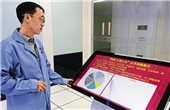Yang Guangwen: Builder of the Most Powerful Computer
China Today by Lu Rucai, October 13, 2016 Adjust font size:
Applications
Fu Haohuan returned from Stanford to teach at Tsinghua in late 2010 when Tianhe-1A had just taken first place on the TOP500. His Tsinghua colleague told him that an American scientist had asked: “You got first place, but how about your applications? Can you make full use of the system?”
“There is a lot of skepticism about China’s supercomputing,” Fu said. The CPU and chips were imported from the U.S, which means the Tianhe-2 reflects a high capacity for integration. However, more attention should be paid to whether it can facilitate applications and solve scientific problems.
Taking applications into consideration, the National Supercomputing Center in Wuxi insisted on tackling both tasks at the same time – testing the machine and developing applications – from the very start.
In just over six months from when trials began in December 2015, over 60 applications have been developed in 19 areas, including weather and climate; aerospace; marine environment; biomedicine; marine engineering; new materials; and advanced manufacturing.
Among these, three projects have been nominated for the Gordon Bell Prize, an award presented by the Association for Computing Machinery. They are: A Highly Effective Global Surface Wave Numerical Simulation with Ultra-High Resolution; Extreme-Scale Phase Field Simulations of Coarsening Dynamics on the Sunway TaihuLight Supercomputer; and 10M-Core Scalable Fully-Implicit Solver for Nonhydrostatic Atmospheric Dynamics.
The Gordon Bell Award, established in 1987, is the world’s most prestigious award in high-performance computing applications. American scientific groups consistently won the award for the first 20 years, until Japan’s Earth Simulator won the prize in 2002. In recent years, the prize has been monopolized by the U.S. and Japan with occasional wins by European institutions. Chinese scientific teams have not made the shortlist until this year, which Fu called “inspiring.”
Participants in the application projects had personal experience of the calculation capacity of Sunway TaihuLight. The National Laboratory for Computational Fluid Dynamics completed large-scale parallel computing on the Sunway TaihuLight in just 20 days – a process which used to take as long as 12 months. The results were also in accordance with wind tunnel test results.

